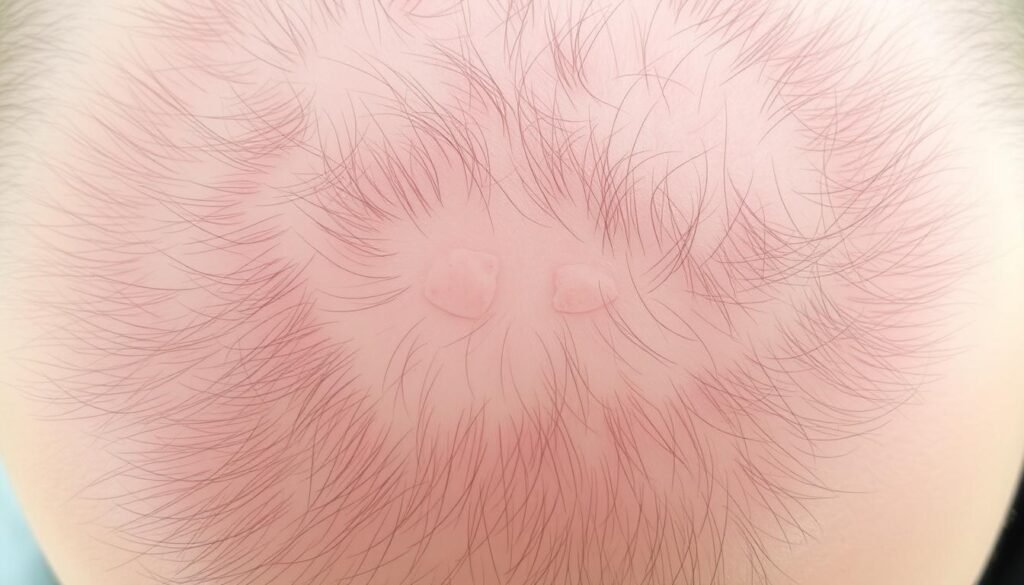About 6.8 million people in the US struggle with alopecia. Yet, myths about hair loss make it hard for many to really understand what alopecia is. The spread of false ideas leads to unfair judgement against those who have the condition. Our goal is to clear up these myths by sharing real facts and insights about alopecia. We want to help people know what’s true and what’s not. By doing this, we aim to increase awareness and empathy towards those dealing with alopecia.
Key Takeaways
- Alopecia affects millions, yet many misunderstand its nature and impact.
- Common myths contribute to societal stigma around hair loss.
- Educating oneself about alopecia can help dispel myths and promote empathy.
- Understanding the emotional and psychological toll of hair loss is crucial.
- Accurate information about alopecia can lead to better support for those affected.
Understanding Alopecia: An Overview
Alopecia is an autoimmune disorder that affects hair health. It leads to various degrees of hair loss. People see this condition show up in different ways. It’s crucial to know the types of alopecia and their traits to tackle the issue well.
What is Alopecia?
Alopecia causes hair loss in many. It can hit hair on the scalp and other parts of the body. Recognizing alopecia means seeing it’s not just about looks but health. It arises from stress, genes, and the body’s immune actions.
Types of Alopecia: A Quick Guide
We have different kinds of alopecia. Each type stands out with its own features:
- Alopecia Areata: This kind leads to quick hair loss in spots and can hit anyone, no matter their age.
- Androgenetic Alopecia: Also known as male or female pattern baldness. It comes from genes and often shows as hairline receding or hair thinning.
- Telogen Effluvium: This type happens after big stressors like sickness or trauma, causing more hair to fall out.
Every alopecia type has its triggers for hair loss. Knowing these helps in controlling the condition. By spotting the signs and forms of alopecia, people can look for the right help and support.
The Psychology Behind Hair Loss
Hair loss can lead to anxiety, depression, and lower self-esteem. It changes how one sees themselves and their identity. The stigma of losing hair can make people feel inadequate.
Emotional Impact of Hair Loss
How people feel about hair loss varies. Some grieve for their lost youth and beauty. They may avoid social settings and feel worse.
Studies show hair loss can lower social confidence and self-worth. It’s a big emotional challenge for many.
Societal Pressures and Hair Aesthetics
Society and media push an ideal look, often showing thick, shiny hair as the best. Not fitting this image can make people feel left out. To understand these issues, check out research from the International Journal of Dermatology and the American Psychological Association.
Debunking Alopecia Myths
Many people believe incorrect ideas about alopecia. These Hair Loss Myths can change how we see the condition and keep stigma alive. By debunking Alopecia myths, we can truly understand this issue. It affects many different people.
Common Myths About Alopecia
There are many false beliefs about alopecia. This misinformation leads people astray. Some of these myths are:
- Alopecia is only a cosmetic issue.
- Only men experience hair loss.
- Alopecia is contagious.
- Stress is the primary cause of hair loss.
The Truth Behind Hair Loss Misconceptions
Knowing the truth about alopecia is key to Alopecia Awareness. Studies show it hits both males and females, from any age group. It’s linked to different causes, like genetics and autoimmune issues. When we understand the truth behind these Hair Loss Myths, we can offer better support and kindness to those suffering.

Alopecia Areata: Facts You Need to Know
Alopecia Areata causes patchy hair loss. Knowing the reasons and spotting the signs early helps manage it.
Causes of Alopecia Areata
It stem from genetics and the immune system’s reactions. Often, the immune system wrongly targets hair follicles, causing unexpected hair loss. Although the precise cause is murky, key factors include:
- Family history and genetic predisposition
- Autoimmune disorders
- Environmental triggers, like stress or trauma
Symptoms and Diagnosis
The main sign of Alopecia Areata is rapid loss of hair in patches. These can appear on the scalp or body. Hair might fall out in circles or ovals. You may also see:
- Thinning hair near the patches
- Nail texture changes, such as pitting or ridges
- Odd patterns of hair loss
Doctors usually start with a detailed check-up and might do scalp biopsies. They use symptoms and health history to diagnose Alopecia Areata.

| Symptom | Description |
|---|---|
| Bald patches | Sudden hair loss in round or oval patches |
| Thinning hair | Progressive thinning around bald patches |
| Nail changes | Pitting or ridges observed in the nails |
Exploring Hair Loss Causes
Looking into why hair loss happens involves understanding many factors. These can be split into genetics and the world around us. Knowing about these helps us take better care of our hair.
Genetic Factors in Hair Loss
Our genes have a big part in whether we might lose hair. Many studies show that patterns of baldness come from our families. If hair loss runs in the family, we might be more likely to experience it too. Being aware of this helps us deal better with hair loss.
Environmental Influences on Hair Health
What’s around us greatly impacts our hair’s health. Things like air pollution, stress, and harsh chemicals harm our hair. They can make it harder for us to keep our hair thick and growing. Hairlab Chicago offers advice on handling these issues for better hair care.

Alopecia Treatments: What Works?
Alopecia is tough, but there are many treatments that help. Knowing your options is key to getting your hair back. We will look at approved drugs and other methods to fight alopecia.
Medications for Hair Regrowth
Medications are often the first step in treating alopecia. Minoxidil and finasteride are two FDA-approved options. Minoxidil boosts blood flow and wakes up hair follicles. Finasteride is mainly for men, blocking the hormone that thins hair.
Many users say these drugs helped them a lot. But, always talk to a doctor first to find what’s best for you.
Alternative Therapies and Natural Remedies
Looking for a natural route? Alternative methods might help your hair too. Things like acupuncture and herbal mixes show promise. Rosemary and Fenugreek Extra Strength Herbal Hair Growth is getting attention.
Choosing the best alopecia treatment depends on what you prefer. Knowing your options can help you get closer to seeing your hair grow back.
Bald Truths: Myths vs. Reality
It’s vital to understand how male and female hair loss differ. Our discussions show big disparities, largely due to genes and hormones. Knowing this helps us see the stigma around baldness differently. This stigma can really affect someone’s confidence and mental health.
Facts About Male vs. Female Hair Loss
Male and female hair loss don’t look the same. Men often get a receding hairline and bald spots, while women typically notice thinning all over. These differences highlight how hormones and genes play a role. Recognizing these variations helps us empathize with what others go through.
| Aspect | Male Hair Loss | Female Hair Loss |
|---|---|---|
| Pattern | Receding hairline, bald spots | Thinning all over the scalp |
| Causes | Genetic predisposition, hormones | Hormonal changes, genetics, stress |
| Age of Onset | Late teens to early twenties | Post-puberty, worsening with age |
| Perception | Often accepted; cultural norms | Stigmatized; societal pressures |
Understanding the Stigma of Baldness
The stigma around baldness affects men and women differently. While men may view it as a sign of honor, women often face harsher judgments. This highlights the need to challenge and change our biases. By educating ourselves, we can fight these stereotypes. To learn more about these issues, check out Bald Truths for insights on societal attitudes towards hair loss.
Alopecia Awareness and Advocacy
Alopecia Awareness is key in breaking down myths and building understanding. It involves teaching others about the emotional impacts of hair loss. By sharing stories, we create a supportive community.
The Importance of Educating Others
Talking about alopecia helps fight off stigma. It’s often misunderstood, making those affected feel alone. Through outreach and education, we can change perceptions. Sharing personal stories, like Laura Mathias’s, helps build empathy. An educated community offers stronger support to those dealing with alopecia.
Support Resources for Those Affected
There are many resources available for those with alopecia. National groups offer info and connections, while local ones offer a space to share and feel safe. This support builds a strong community and helps with emotional health. Below is a chart of some main organizations and what they do for those with alopecia:
| Organization | Website | Services Offered |
|---|---|---|
| Alopecia Areata Foundation | Alopecia Areata Foundation | Research funding, educational resources, community support |
| National Alopecia Areata Coalition | National Alopecia Areata Coalition | Advocacy, online forums, fundraising events |
| Local Support Groups | N/A | Peer support, social activities, educational workshops |
Conclusion
Understanding alopecia means clearing up many wrong ideas about hair loss. We must correct these myths to help those affected. This also helps everyone know more about hair loss. Talking about how hair loss feels shows why kindness and learning matter.
We need to rely on true facts about alopecia. This way, we can talk openly about hair loss experiences. The right info fights off bad judgments and brings acceptance. Knowing that alopecia doesn’t shape who you are is key. Support greatly helps in overcoming its hardships.
Talking more about alopecia boosts confidence in those who have it. When communities come together, they build a strong support network. This helps us all be more accepting and inclusive. Together, we can stop exclusion and celebrate everyone’s hair loss story.